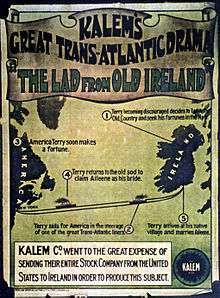The Lad from Old Ireland
| The Lad from Old Ireland | |
|---|---|
 | |
| Directed by | Sidney Olcott |
| Written by | Gene Gauntier |
| Starring |
Sidney Olcott Gene Gauntier Thomas O'Connor |
| Cinematography | George K. Hollister |
| Distributed by | Kalem Company |
Release dates | November 23, 1910 |
| Country | United States |
| Language | Silent (English intertitles) |
The Lad from Old Ireland, also called A Lad from Old Ireland, is a one-reel 1910 American motion picture directed by and starring Sidney Olcott and written by and co-starring Gene Gauntier. It was the first film appearance of prolific actor/director J.P. McGowan.
Production background
The film was the first ever production by an American movie studio to be filmed on location outside of the United States. Filming took place around Cork and Killarney in Ireland, and in New York City.[1]
In August 1910, the Kalem Company of New York City sent director Sidney Olcott and a film crew to film in Europe. In Ireland, Olcott made The Lad From Old Ireland from a script written by Gene Gauntier. Shot by cinematographer George K. Hollister, the film was described in the publicity releases for its November premiere as "Kalem’s Great Trans-Atlantic Drama."[2]
Plot
An Irish boy (Olcott) emigrates to America to escape the desperate poverty of Ireland. After finding work in construction, he finds success in politics. He returns to Ireland after receiving a letter from his sweetheart (Gauntier) just as her destitute family is being forced off their land.[3]
Cast
- Sidney Olcott : Terry O'Connor
- Gene Gauntier : Aileene
- Thomas O'Connor : The landlord
- Arthur Donaldson : Parish priest
- J.P. McGowan : Election agent
- Robert G. Vignola : Election agent
- Jane Wolfe : Society woman
- Agnes Mapes : Aileene's mother
- Laurene Santley
Reception
The film was a critical and popular success, particularly with Irish immigrants in America. Unlike previous films, the Irish characters were not cartoonish caricatures, and the story was a familiar and hopeful one for immigrants. The success prompted Kalem to send a larger company under the direction of Olcott the next year in 1911, which produced 18 films that summer.[1][2]
The Moving Picture World noted that the film was "quite a success", but complained that the audience was not informed of and thus unable to appreciate "the important characteristics of the picture", referring to the authentic portrayal of Irish rural life.[4]
See also
References
- 1 2 Langan, Sheila (January 2012). "Blazing the Trail to Ireland: The Kalem Film Company". Irish America. Retrieved December 31, 2015.
- 1 2 Flynn, Arthur (2005). The Story of Irish Film. Dublin: Currach Press. p. 13-15. ISBN 9781856079143.
- ↑ "Irish Silent Films". Trinity College, Dublin. November 9, 2011. Retrieved December 30, 2015.
- ↑ "Observations By Our Man About Town". The Moving Picture World. Vol. 7 no. 24. New York: The World Photographic Publishing Company. December 10, 1910. p. 1343. Retrieved October 24, 2016.
Further reading
- Michel Derrien, Aux origines du cinéma irlandais: Sidney Olcott, le premier oeil, TIR 2013. ISBN 978-2-917681-20-6 (French)
External links
- The Lad from Old Ireland at the Internet Movie Database
- Kalem Company filming in Ireland
- (French) The Lad from Old Ireland website dedicated to Sidney Olcott
- Restored film by Trinity College, Dublin at YouTube